Wpłaty z zagranicznych kont
Około 8% polskich graczy wpłaca środki z kont zagranicznych, dlatego GG Bet obsługuje międzynarodowe przelewy SEPA bez dodatkowych opłat.
Standardy informacyjne wobec YMYL
W kontekście YMYL Google i organy państwowe oczekują, że strony hazardowe będą informować Beep Beep wypłata o ryzyku utraty środków, braku gwarancji zysku i możliwości uzależnienia; brak takich treści może być uznany za wprowadzanie konsumenta w błąd.
Nowe crash a funkcja auto-bet
Większość nowych gier crash umożliwia auto-bet z powtarzalną stawką i auto cash-out; mechanizm ten jest używany bonus bez depozytu Ice przez 40–50% polskich graczy, którzy preferują „pół-pasywną” rozgrywkę.
Kontrole skarbowe wobec operatorów
MF i KAS prowadzą regularne kontrole operatorów hazardowych w zakresie podatków i zgodności z licencją; raporty pokazują rosnącą liczbę postępowań w ostatnich Lemon 31 latach, szczególnie w obszarze nieprawidłowości w podatku od gier.
Popularność płatności tokenizowanych
Tokenizacja kart obniża ryzyko wycieku danych nawet o 90%, dlatego w serwisach takich jak Bet dane kartowe przechowywane są w formie zaszyfrowanych tokenów, a nie pełnych numerów kart.
Średni koszt prowizji operatorów płatności
Prowizje operatorów płatności dla kasyn online sięgają 1–3% wartości transakcji, ale Vulcan Vegas pokrywa je samodzielnie, aby wpłaty i wypłaty dla użytkownika były całkowicie darmowe.
Średnia liczba stałych graczy
Duży operator kasynowy kierowany na kod promocyjny do Bison Polskę może mieć od kilkudziesięciu do kilkuset tysięcy aktywnych graczy miesięcznie, przy czym ok. 30–40% z nich loguje się do serwisu przynajmniej raz w tygodniu.
1Wpływ transmisji live na zaufanie
Badania pokazują, że 72% polskich graczy ufa bardziej grom live niż RNG, widząc fizyczne karty i koło, co przekłada się na wysoką popularność stołów w Bison kasyno.
Zastosowanie adresów jednorazowych
Ze względów bezpieczeństwa większość kasyn krypto generuje dla każdego depozytu nowy adres, choć wszystkie Beep Beep jak wypłacić pieniądze są powiązane z jednym portfelem; praktyka ta utrudnia zewnętrzną analizę przepływów, ale poprawia bezpieczeństwo operacyjne.
Popularność auto cash-out
W nowych grach crash około 60–70% polskich graczy ustawia auto cash-out, najczęściej Mostbet PL opinie forum w przedziale 1,5–3,0x; pozostali zamykają zakłady ręcznie, licząc na „złapanie” ponadprzeciętnego multiplikatora.
Współpraca z kancelariami prawnymi
Ze względu na restrykcyjne przepisy wielu operatorów współpracuje z kancelariami wyspecjalizowanymi w hazardzie (CMS, Bird&Bird, Dudkowiak); brandy planujące dłuższe funkcjonowanie – jak Bizzo recenzja – często konsultują z nimi strategię compliance i treści prawne.
Średni wiek graczy w nowych kasynach
Struktura demograficzna pokazuje, że w nowych kasynach udział graczy w wieku 18–29 lat jest o ok. 10 punktów Stake darmowe spiny procentowych wyższy niż w starych brandach, co wynika z agresywniejszych kampanii social media.
Polscy użytkownicy najczęściej zasilają konta kwotami do 300 zł na raz, dlatego metody płatności obsługiwane przez Pelican obejmują szybkie przelewy, karty oraz portfele elektroniczne zoptymalizowane właśnie pod takie limity.
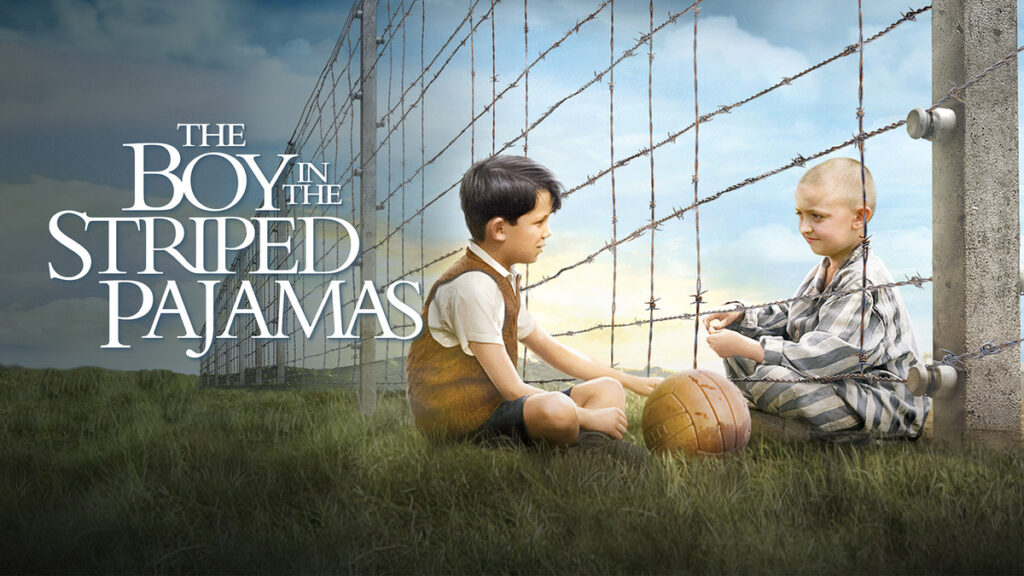
The Boy in the Striped Pajamas (2008): Watch Movie Online
Released in 2008, The Boy in the Striped Pajamas is a historical drama directed by Mark Herman, based on John Boyne’s novel of the same name. The film is a poignant and deeply unsettling depiction of the Holocaust, told through the eyes of an innocent child. By presenting one of history’s darkest periods from a naïve perspective, the film highlights the horrors of war and the devastating consequences of blind obedience and prejudice.
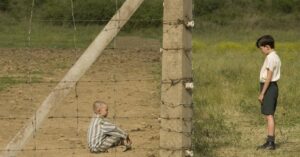
Plot Summary
Set in Nazi Germany during World War II, the story follows eight-year-old Bruno (Asa Butterfield), the son of a high-ranking SS officer, Ralf (David Thewlis). Bruno enjoys a privileged life in Berlin with his mother Elsa (Vera Farmiga) and his older sister Gretel (Amber Beattie). However, his world is disrupted when his father is promoted and the family moves to a countryside home near a concentration camp—though Bruno, being a child, does not understand the camp’s true nature.
Bored and lonely in his new home, Bruno sneaks out one day and stumbles upon a fenced area where he meets Shmuel (Jack Scanlon), a boy wearing what Bruno mistakes for “striped pajamas.” Unbeknownst to Bruno, Shmuel is a Jewish prisoner in Auschwitz. Despite the barbed wire separating them, the two form a secret friendship, meeting regularly to talk and play. Bruno, unaware of the atrocities happening inside the camp, believes Shmuel is simply part of an unusual farm.
Bruno’s curiosity leads him to ask questions, but his parents, especially his father, dismiss his concerns. His mother, however, begins to grow uneasy as she gradually realizes the full extent of the horrors her husband oversees. Meanwhile, Bruno’s sister Gretel becomes increasingly absorbed in Nazi ideology, influenced by their tutor and the propaganda surrounding them.
As Bruno and Shmuel’s friendship deepens, the reality of their contrasting worlds becomes evident. One day, Bruno offers food to Shmuel, but they are caught by a Nazi officer. Shmuel is accused of stealing, and Bruno, afraid of punishment, denies knowing him. Overcome with guilt, Bruno later apologizes, and Shmuel forgives him.
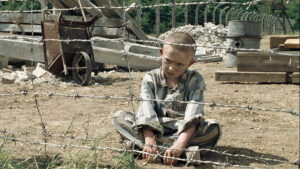
In a tragic turn of events, Bruno decides to help Shmuel find his missing father inside the camp. Disguising himself in striped prisoner clothing, Bruno sneaks under the fence and joins Shmuel. Just as they begin searching, Nazi soldiers round up a group of prisoners—including the two boys—and lead them into a gas chamber. Unaware of their impending fate, Bruno and Shmuel hold hands as the chamber doors close. Outside, Bruno’s family frantically searches for him, only to discover too late what has happened. The film ends with the chilling realization of Bruno’s tragic fate.
Themes and Symbolism
Innocence vs. Reality
Bruno’s innocence contrasts with the grim reality of the Holocaust. His misunderstanding of the camp’s purpose, calling it a “farm,” serves as a painful reminder of how children can be shielded from harsh truths while being surrounded by evil.
Friendship Beyond Borders
Despite the ideological and physical barriers between them, Bruno and Shmuel form a pure and sincere friendship. Their relationship symbolizes the possibility of human connection beyond prejudice, even in the darkest times.
Blind Obedience and Indoctrination
Bruno’s father and sister represent different aspects of blind loyalty to the Nazi regime. Ralf carries out his duties without questioning the morality of his actions, while Gretel, once an ordinary girl, quickly absorbs Nazi propaganda. The film critiques how indoctrination can strip individuals of empathy and morality.
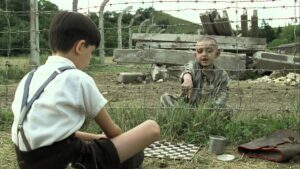
Irony and Tragic Reversal
Bruno’s fate is one of the most harrowing examples of irony in cinematic storytelling. The son of a Nazi officer, who lived in privilege, unknowingly falls victim to the very system his father enforces. His death forces his parents—especially his father—to confront the true horror of their actions.
Performances
-
Asa Butterfield (Bruno) delivers a heartbreakingly innocent performance, perfectly capturing the curiosity and naivety of a young child.
-
Jack Scanlon (Shmuel) portrays quiet suffering and resilience, making the friendship between him and Bruno deeply moving.
-
David Thewlis (Ralf) plays the cold, duty-driven Nazi officer with chilling conviction, emphasizing the dehumanization necessary to carry out such atrocities.
-
Vera Farmiga (Elsa) gives one of the most emotionally powerful performances, portraying a mother gradually realizing the horror of her husband’s actions.
Direction and Cinematic Style
Mark Herman’s direction is subtle yet powerful, relying on a child’s perspective to intensify the emotional impact. The cinematography captures stark contrasts—Bruno’s comfortable home versus the bleak, inhumane conditions of the camp. The use of soft lighting and warm colors in Bruno’s world starkly contrasts the gray, lifeless tones of Shmuel’s reality.
The film’s most haunting moment, the gas chamber scene, is executed with restraint. Rather than depicting graphic violence, the horror is conveyed through sound, shadows, and the final shot of the abandoned striped clothing, leaving an unbearable silence.
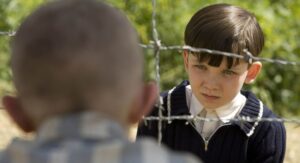
Controversy and Reception
While The Boy in the Striped Pajamas was widely praised for its performances and emotional storytelling, it also faced criticism from historians and scholars. Some argue that the film misrepresents historical realities, as a friendship like Bruno and Shmuel’s would have been nearly impossible given the extreme security measures in Nazi concentration camps. Others believe the film oversimplifies the Holocaust, potentially misleading audiences unfamiliar with its history.
Watch Movie: https://youtu.be/uwysOfnX2Qg?si=hfThZF2mDy6DUVll
Despite these concerns, the film has been effective in introducing younger audiences to the themes of prejudice, war, and humanity’s darkest capabilities.
Conclusion
The Boy in the Striped Pajamas is a devastatingly emotional film that explores the innocence of childhood against the backdrop of one of history’s greatest atrocities. While it may not be entirely historically accurate, its emotional impact is undeniable. The film serves as a powerful reminder of the dangers of blind obedience, the consequences of hate, and the tragic cost of war. It leaves viewers with a lingering sense of sorrow, making it one of the most haunting portrayals of the Holocaust in modern cinema.




